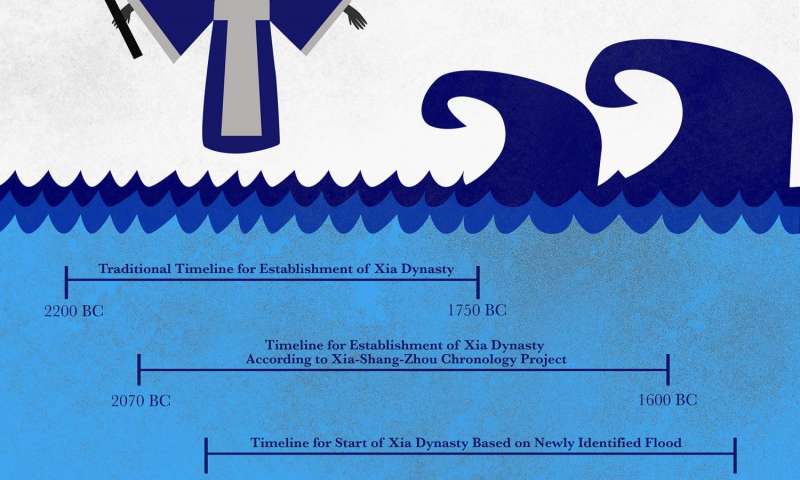This is the famous flood of the yellow emperor Yu that is being talked about, dating back to around 4000 years ago. It is mentioned by Paul Dunbavin in The Atlantic Researches and by Moe Mandelkehr in The 2300BC Event (as well as various other catastrophist authors), but most importantly emperor Yu sits at the very beginning of the Xia dynasty. To put it into context Xia ran contemporary with Middle Kingdom Egypt and Middle Bronze Age in the Levant and Mesopotamia. It began with a disaster (which included the flood of Yu) and ended in a disaster (eventually ushering in the Shang dynasty). Prior to Xia was the Chinese Neolithic period. Those disasters represent loss of the mandate of the heavens and on both occasions seem to include heavy meteoric activity. That activity in turn has a chronological value if the meteoric activity can be pinned down to historical dates. It might be that narrow growth tree ring events can do this – as suggested by Mike Baillie in one of his books. However, if these are solely due to volcanic activity that is not possible. Logic would dictate that heavy meteoric activity left behind a lot of dust in the upper atmosphere – which created an opaque sky, and therefore temperatures at the surface of the Earth would drop. At the moment it is fashionable just to see these events as volcano driven – but fashions come and go.
What the Chinese have found is evidence of an earthquake driven massive landslide that caused the Yellow River to bung up and large amounts of water built up behind the soil and earth. When the bung was eventually breached it caused a massive flood of water to come rushing down the river – and must have caused a large loss of life. In legend Yu is associated with taking control of the flood waters and putting in operation dredging works that made the river flow more manageable. Historians, mainly western it has to be acknowledged, have regarded him as a legendary or even mythic figure, but it would seem the flood was a defining moment – and gave rise to a period of peace and prosperity under the Xia emperors. Whether the flood that has been discovered is that of Yu is open to debate as others have dated Yu or Yao somewhat earlier – even to as early as 3000BC. However, if we acknowledge he established the Xia dynasty and it proceeded within a stable environment for several hundred years, and then the position as defined in this research seems eminently feasible. If he had lived, for instance, around 2300BC, or shortly thereafter, he would have had to contend with a recurring series of problems if the situation in the First Intermediate Period is taken into account. As somebody that received the mandate of heaven it can only mean that he preceded an era of prosperity and calm in the natural world – especially in the sky.
The date of 1920 was achieved by C14 methodology from the bones of a child overcome in the earthquake – see http://phys.org/print389545889.html (and variously other links such as www.yahoo.com/news/first-evidence-legendary-china-flood-may-rewrite-hist… (the study was published in the journal Science which provides a nice graph – below)
 You may note the traditional date is very close to the date of Moe Mandelkehr and the middle range close to that of the low growth tree ring events and the calibrated C14 data. The bottom date line is close to a revised C14 range some 150 years lower than mainstream allows at present based on the C14 discrepancy on bones found at Nineveh in its final moments.
You may note the traditional date is very close to the date of Moe Mandelkehr and the middle range close to that of the low growth tree ring events and the calibrated C14 data. The bottom date line is close to a revised C14 range some 150 years lower than mainstream allows at present based on the C14 discrepancy on bones found at Nineveh in its final moments.
